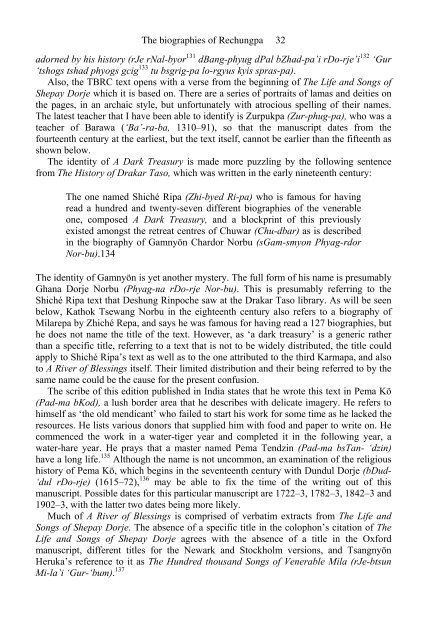The Biographies of Rechungpa: The Evolution of a Tibetan ...
The Biographies of Rechungpa: The Evolution of a Tibetan ...
The Biographies of Rechungpa: The Evolution of a Tibetan ...
Create successful ePaper yourself
Turn your PDF publications into a flip-book with our unique Google optimized e-Paper software.
<strong>The</strong> biographies <strong>of</strong> <strong>Rechungpa</strong> 32<br />
adorned by his history (rJe rNal-byor 131 dBang-phyug dPal bZhad-pa’i rDo-rje’i 132 ‘Gur<br />
‘tshogs tshad phyogs gcig 133 tu bsgrig-pa lo-rgyus kyis spras-pa).<br />
Also, the TBRC text opens with a verse from the beginning <strong>of</strong> <strong>The</strong> Life and Songs <strong>of</strong><br />
Shepay Dorje which it is based on. <strong>The</strong>re are a series <strong>of</strong> portraits <strong>of</strong> lamas and deities on<br />
the pages, in an archaic style, but unfortunately with atrocious spelling <strong>of</strong> their names.<br />
<strong>The</strong> latest teacher that I have been able to identify is Zurpukpa (Zur-phug-pa), who was a<br />
teacher <strong>of</strong> Barawa (‘Ba’-ra-ba, 1310–91), so that the manuscript dates from the<br />
fourteenth century at the earliest, but the text itself, cannot be earlier than the fifteenth as<br />
shown below.<br />
<strong>The</strong> identity <strong>of</strong> A Dark Treasury is made more puzzling by the following sentence<br />
from <strong>The</strong> History <strong>of</strong> Drakar Taso, which was written in the early nineteenth century:<br />
<strong>The</strong> one named Shiché Ripa (Zhi-byed Ri-pa) who is famous for having<br />
read a hundred and twenty-seven different biographies <strong>of</strong> the venerable<br />
one, composed A Dark Treasury, and a blockprint <strong>of</strong> this previously<br />
existed amongst the retreat centres <strong>of</strong> Chuwar (Chu-dbar) as is described<br />
in the biography <strong>of</strong> Gamnyön Chardor Norbu (sGam-smyon Phyag-rdor<br />
Nor-bu).134<br />
<strong>The</strong> identity <strong>of</strong> Gamnyön is yet another mystery. <strong>The</strong> full form <strong>of</strong> his name is presumably<br />
Ghana Dorje Norbu (Phyag-na rDo-rje Nor-bu). This is presumably referring to the<br />
Shiché Ripa text that Deshung Rinpoche saw at the Drakar Taso library. As will be seen<br />
below, Kathok Tsewang Norbu in the eighteenth century also refers to a biography <strong>of</strong><br />
Milarepa by Zhiché Repa, and says he was famous for having read a 127 biographies, but<br />
he does not name the title <strong>of</strong> the text. However, as ‘a dark treasury’ is a generic rather<br />
than a specific title, referring to a text that is not to be widely distributed, the title could<br />
apply to Shiché Ripa’s text as well as to the one attributed to the third Karmapa, and also<br />
to A River <strong>of</strong> Blessings itself. <strong>The</strong>ir limited distribution and their being referred to by the<br />
same name could be the cause for the present confusion.<br />
<strong>The</strong> scribe <strong>of</strong> this edition published in India states that he wrote this text in Pema Kö<br />
(Pad-ma bKod), a lush border area that he describes with delicate imagery. He refers to<br />
himself as ‘the old mendicant’ who failed to start his work for some time as he lacked the<br />
resources. He lists various donors that supplied him with food and paper to write on. He<br />
commenced the work in a water-tiger year and completed it in the following year, a<br />
water-hare year. He prays that a master named Pema Tendzin (Pad-ma bsTan- ‘dzin)<br />
have a long life. 135 Although the name is not uncommon, an examination <strong>of</strong> the religious<br />
history <strong>of</strong> Pema Kö, which begins in the seventeenth century with Dundul Dorje (bDud-<br />
‘dul rDo-rje) (1615–72), 136 may be able to fix the time <strong>of</strong> the writing out <strong>of</strong> this<br />
manuscript. Possible dates for this particular manuscript are 1722–3, 1782–3, 1842–3 and<br />
1902–3, with the latter two dates being more likely.<br />
Much <strong>of</strong> A River <strong>of</strong> Blessings is comprised <strong>of</strong> verbatim extracts from <strong>The</strong> Life and<br />
Songs <strong>of</strong> Shepay Dorje. <strong>The</strong> absence <strong>of</strong> a specific title in the colophon’s citation <strong>of</strong> <strong>The</strong><br />
Life and Songs <strong>of</strong> Shepay Dorje agrees with the absence <strong>of</strong> a title in the Oxford<br />
manuscript, different titles for the Newark and Stockholm versions, and Tsangnyön<br />
Heruka’s reference to it as <strong>The</strong> Hundred thousand Songs <strong>of</strong> Venerable Mila (rJe-btsun<br />
Mi-la’i ‘Gur-‘bum). 137











